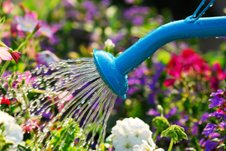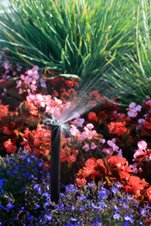Watering Plants – Tips and Techniques
Signs of over watering include wilting, yellow leaves, floppy stems, and evidence of mold growth on the soil surface.
Under watering signs are more obvious. Signs include dry soil – if plant is potted, soil will pull away from the sides of the container. Foliage and flowers will show signs of dryness and wilting.
Watering House Plants – Keeping Them Healthy
Remember, the amount and frequency of watering depends on many factors,
such as species, size, location, and soil mix.
many factors,
such as species, size, location, and soil mix. The watering instructions included with the plant you purchase might be generic. Take the time to research the specific needs of the plant. An abundance of information regarding plant care and watering plants is available online.
If you prefer having the information at your fingertips, consider buying a book devoted to house plant care.
Basic Watering Tips for House Plants
- Pots should have adequate drainage (usually a hole in the
bottom of the pot).
- Check moisture by sticking your finger into the soil up to
the first joint. If the soil is almost dry at your fingertip, it’s time
to water the plant.
- Water the plant until water runs out the bottom of the pot.
This will flush out excess salt build-up as well as ensure the bottom
of the pot receives sufficient water.
- Do not let the pot sit in standing water, this can cause root damage.
Tips for Watering Outdoor Plants
As with house plants, the amount and frequency of watering outdoor plants depends on species, size, location in the garden or
landscape, and soil conditions. Follow these general guidelines for
water outdoor plants:
outdoor plants depends on species, size, location in the garden or
landscape, and soil conditions. Follow these general guidelines for
water outdoor plants:
- Water the soil around the roots of the plant. Soil should
be moist, but not soggy.
- Take enough time to ensure the water soaks into the soil to
reach the bottom of the plant roots. Shallow watering can limit root
growth and survival.
- The best time to water outdoor plants is during moderate temperatures and calm winds. Water is less likely to evaporate, freeze, or be blown away from the soil.
Tools that Make Watering
Plants Effortless and Enjoyable
Garden Hose
A garden hose is an essential tool for watering chores in the garden
and landscape. Purchase a high quality garden hose that is 4-6 ply in
thickness, and equipped with brass fittings. Garden hoses come in a
variety of lengths – be sure to know the distance requirements before
you purchase the hose.
Watering Wand
A watering wand is ideal for watering seeds, young plants, and
hard-to-reach locations (such as hanging baskets). Water flows through
the nozzle in a soft shower, making it easy to water delicate plants
and flowers. High quality watering wands come in a variety of lengths
and are equipped with brass shut off valves.
Watering Can
A watering can is a portable container, usually equipped with a handle
and spout, used watering plants and flowers by hand. They are available
in a variety of styles and materials. Some styles are equipped with a
circular filter at the end of the spout that breaks up the stream of
water. Water cans typically made out of metal, ceramic, or plastic.
Water Hose Nozzles
Water hose nozzles allow you to adjust the water flowing from the
garden hose. The spray pattern can be narrow or wide, water pressure
can be hard or soft. Water hose nozzles are available in a variety of
styles and materials.
Root Irrigator
A root irrigator sends water and air to the hard to reach roots of
trees and shrubs. This allows roots to receive improved aeration and
better absorption of fertilizer. The root irrigator is attached to a
garden hose, and then inserted into the ground near the root source.






